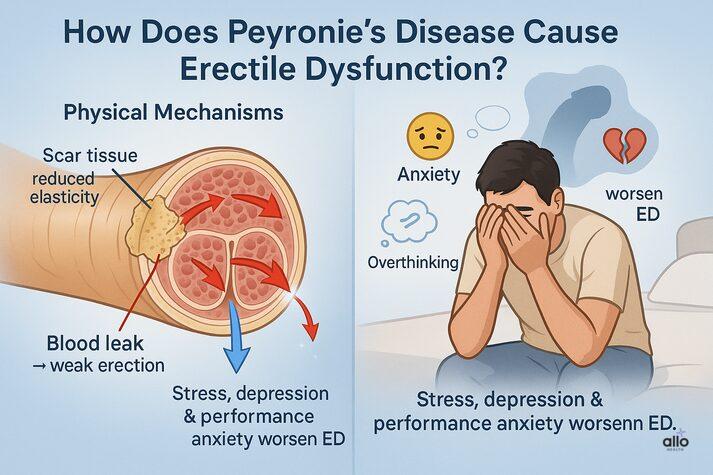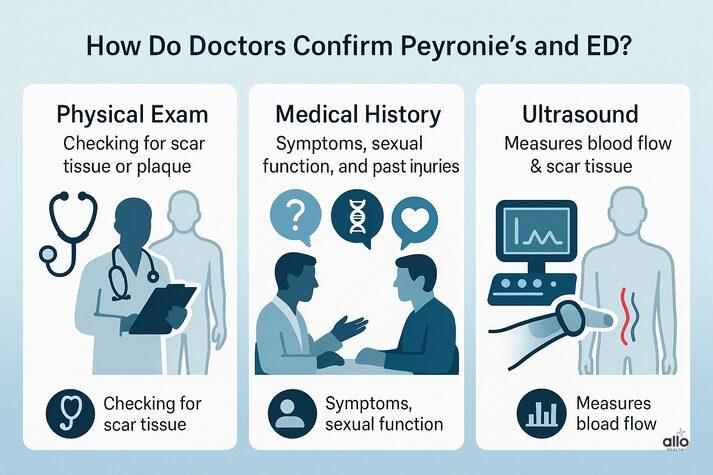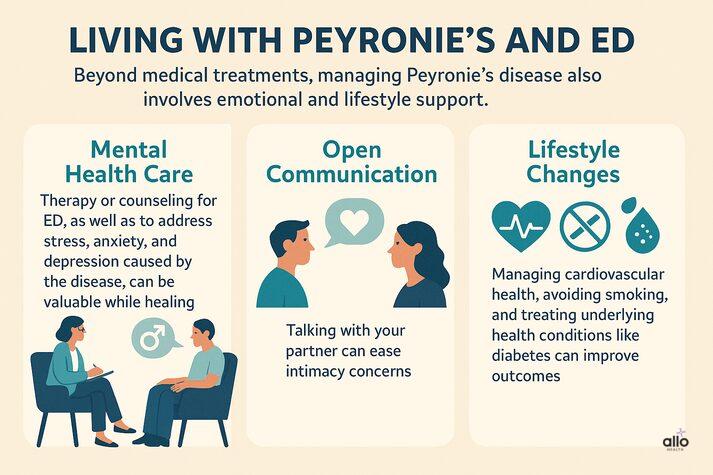Peyronie’s Disease and Erectile Dysfunction: Link and Effects on Sexual Health

Yes, Peyronie’s disease can cause erectile dysfunction because scar tissue inside the penis can block blood flow and reduce flexibility, making erections weaker or painful. The connection isn’t just physical; anxiety and low confidence can also play a role. The good news? Both Peyronie’s and ED are treatable with early diagnosis, medications, traction therapy, or surgery. If you notice changes like curvature or discomfort, seeing a doctor early can help restore both function and confidence.
Many men hear about Peyronie’s disease and think of it only as a condition that causes a curved erection. But for many, it brings another concern: erectile dysfunction (ED).
In fact, research shows that between 30–60% of men with Peyronie’s disease also experience some form of ED.[1] This happens because the scar tissue that forms inside the penis due to this disease can block healthy blood flow and reduce flexibility, making it difficult to get or keep a firm erection. Pain and anxiety related to the condition can also add to the problem.
If you or someone you know is worried about this connection, you’re not alone. Let’s break down what Peyronie’s disease is, how it affects sexual function, and what treatments are available to help.
Does Peyronie’s Disease Cause Erectile Dysfunction?
Yes, Peyronie’s disease can cause erectile dysfunction (ED), and the two often go hand in hand. But before we see how Peyronie’s disease leads to erectile dysfunction, let’s first understand what this condition actually is in brief.
What is Peyronie’s Disease?
Peyronie’s disease happens when scar tissue, also called plaque, builds up inside the penis. Normally, the penis contains two long, flexible chambers called the corpora cavernosa. These chambers are wrapped in a tough but stretchy layer known as the tunica albuginea. During sexual arousal, blood flows into the corpora cavernosa, the tunica stretches, and the penis becomes firm and straight.
When Peyronie’s disease develops, the healing process after a small injury (sometimes even unnoticed, like during sex or athletic activities) goes off track. Instead of the tissue repairing smoothly, it creates patches of hard scar tissue in the tunica albuginea. This is how fibrous scar tissue forms.
Because scar tissue doesn’t stretch like healthy tissue, one side of the penis may pull more tightly than the other during an erection. The result is a curved, bent, or hourglass-shaped erection, which can also be painful.
Over time, this lack of flexibility can make it harder for the penis to trap blood effectively, which is why Peyronie’s disease is so closely linked with erectile dysfunction.
Common Symptoms Include:
- A curved erection (bending upward, downward, or to the side)
- Painful erections or pain during sex
- Shortening of penile length
- Difficulty with penetration or maintaining an erection
These changes don’t just affect the body but can take a toll on confidence, intimacy, and mental health. Many men with Peyronie’s disease experience anxiety, stress, or depression related to their sexual function.
Is Peyronie’s Disease Itself a Sexual Dysfunction?
Yes. Like ED, Peyronie’s disease is also classified as a sexual dysfunction because it can directly interfere with sexual activity. [2] The scar tissue buildup makes the penis less flexible and can restrict blood flow, which is essential for achieving and maintaining an erection.
It can cause:
- Painful erections
- Reduced desire due to discomfort
- Difficulty or inability to have intercourse in severe cases
And beyond the physical impact, the emotional effects, from performance anxiety to low self-esteem, further add to the problem.

How Does Peyronie’s Disease Cause Erectile Dysfunction?
The link between Peyronie’s disease and ED is both physical and psychological.
1. Physical Mechanisms
- The fibrous scar tissue can interfere with how the penis stores blood during an erection. Without enough trapped blood, erections are weaker or don’t last long.
- Studies show that nearly 60% of men with Peyronie’s and ED struggle with blood “leaking out” too quickly, preventing a firm erection. [3]
- Scar tissue formed due to the disease reduces elasticity, making it difficult for the penis to expand fully. This can cause partial erections, less rigidity, or shortening of the penis.
2. Psychological Factors
- Painful erections can discourage men from sexual activity. [4] Over time, avoiding sex can lead to loss of libido and worsening ED.
- Constantly seeing a deformity in place of an erect penis can often trigger performance anxiety due to the fear of sexual failure.
- 50% of men with Peyronie’s disease suffer from depressive symptoms, stress, or anxiety, which are conditions that can cause ED.

Can ED Cause Peyronie’s Disease?
Yes, while Peyronie’s disease is more commonly a cause of ED, in some cases, the reverse can also be true.
When a man has ED, erections may not be fully firm. During sexual activity with a partial erection, the penis is more vulnerable to bending or injury. Even small, unnoticed injuries can trigger the body’s healing process. Instead of healing smoothly, some of these injuries may lead to the formation of scar tissue (plaque) inside the penis. Over time, this scarring can develop into Peyronie’s disease.
This doesn’t mean that ED always leads to Peyronie’s. But it highlights how these conditions are connected in a cycle:
ED → penile injury → scar tissue → Peyronie’s → worsened ED
So while ED alone doesn’t directly “cause” Peyronie’s disease, it can contribute to the injuries that cause the condition. [5] This is why addressing ED early, through lifestyle changes, medications, or other treatments, may also help lower the risk of developing Peyronie’s later on.

How Do Doctors Confirm Peyronie’s and ED?
If you notice symptoms like penile curvature, painful erections, or difficulty having sex, a doctor may perform several tests to confirm whether it’s Peyronie’s disease, erectile dysfunction, or both. Because these two conditions often overlap, the evaluation usually looks at both the structure of the penis and its erectile function. Some tests include:
- Physical Exam: Feeling for plaque or scar tissue.
- Medical History: Asking about symptoms, sexual arousal, family history, and past injuries.
- Penile Duplex Doppler Ultrasound: A test that measures blood flow and identifies the presence of scar tissue.
Getting diagnosed early is very important. This is because in the first 6–12 months of Peyronie’s disease, non-surgical treatments like medications, traction therapy, or injections work best.[6] At the same time, catching ED early allows for treatments that improve erections and reduce further injury. Let us look at this in detail.

Treatment Options for Peyronie’s Disease and ED
Because Peyronie’s disease and ED often occur together, doctors usually address both conditions simultaneously. Treatments include:
1. Non-Surgical Options
These work best in the first 6-12 months from the onset of the disease and mild ED.
1. Medications (PDE5 inhibitors): Drugs like sildenafil (Viagra) or tadalafil (Cialis) improve blood flow and help with erections.
2. Injections:
- Collagenase injections break down scar tissue.
- Verapamil injections may reduce plaque size.
3. Traction Therapy: Gentle stretching devices can gradually reduce curvature.
4. Vacuum Erection Devices: Help create and maintain erections.
2. Surgical Treatments
For men with severe curvature and ED, surgery may be recommended:
- Plaque Removal or Grafting: Removing scar tissue and adding grafts to restore shape.
- Penile Plication: Shortening the opposite side of the penis to correct curvature.
- Penile Implants: A definitive solution that corrects both curvature and erectile dysfunction.
Living With Peyronie’s and ED
Beyond medical treatments, managing Peyronie’s disease also involves emotional and lifestyle support. These include:
- Mental Health Care: Therapy or counseling for ED, as well as to address stress, anxiety, and depression caused by the disease, can be valuable while healing.
- Open Communication: Talking with your partner can ease intimacy concerns.
- Lifestyle Changes: Managing cardiovascular health, avoiding smoking, and treating underlying health conditions like diabetes can improve outcomes.
It’s important to treat both the physical and emotional sides of Peyronie’s disease. Addressing pain or curvature is one part, but managing anxiety and self-esteem makes recovery smoother.
Conclusion
Peyronie’s disease and erectile dysfunction are closely connected, with scar tissue and penile curvature often leading to difficulties in achieving or maintaining erections. For some men, ED can even set the stage for Peyronie’s by making the penis more prone to injury during partial erections.
The good news is that both conditions are treatable. From medications, traction therapy, and injections in the early stages, to surgical solutions like penile implants for more severe cases, there are options available that address both the physical and emotional challenges.
Most importantly, Peyronie’s disease is far more common than many men realise. If you notice symptoms such as curvature, painful erections, or problems with sexual performance, don’t ignore them. Early diagnosis and treatment give you the best chance to preserve sexual function, reduce discomfort, and regain confidence. With the right medical care, living a healthy and fulfilling sex life is possible.
"The following blog article provides general information and insights on various topics. However, it is important to note that the information presented is not intended as professional advice in any specific field or area. The content of this blog is for general educational and informational purposes only.
Book consultation
The content should not be interpreted as endorsement, recommendation, or guarantee of any product, service, or information mentioned. Readers are solely responsible for the decisions and actions they take based on the information provided in this blog. It is essential to exercise individual judgment, critical thinking, and personal responsibility when applying or implementing any information or suggestions discussed in the blog."






